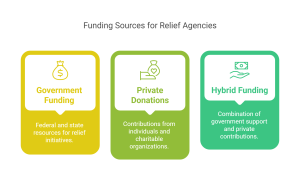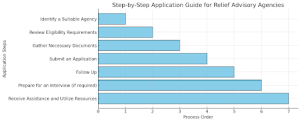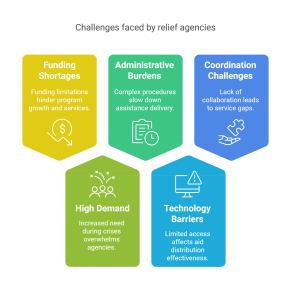Key Takeaways
- Relief Advisory Agencies – Provide essential support in areas such as housing, disaster relief, food security, and financial aid.
- Types of Relief Services – Agencies offer assistance for housing, food, disaster recovery, financial aid, debt relief, medical aid, legal services, and job training.
- Application Process – Identify a suitable agency, review eligibility, gather documents, submit applications, and follow up with approval departments.
- Finding Reliable Agencies – Use trusted sources like FEMA, United Way, and Red Cross to access legitimate services.
- Technology in Relief Efforts – Online applications, mobile apps, and AI chatbots enhance accessibility.
- Community Involvement – Volunteering, donations, and advocacy strengthen relief programs.
- Challenges – Agencies face funding shortages, high demand, and administrative burdens but continue to provide crucial assistance.
Introduction
Relief advisory agencies play a vital role in supporting individuals and communities during financial hardship, natural disasters, and other crises. Whether offering housing assistance, financial aid, or food support, these agencies serve as crucial lifelines for those in need.
In this guide, we will explore the role of relief advisory agencies in the U.S., financial advisor for debt, detailing their functions, types of assistance available, eligibility criteria, and application processes. By understanding how these agencies operate, individuals can make informed decisions and maximize the benefits available to them.
Understanding Relief Advisory Agencies
Relief advisory agencies are organizations that offer guidance and resources to individuals seeking support in various areas such as housing, disaster relief, food security, and financial aid. Their primary goal is to connect people with relief programs that cater to their specific needs.
There are two main types of relief agencies. General relief agencies offer broad support across multiple areas, addressing various needs of individuals and families. Specialized agencies, on the other hand, focus on specific issues such as debt relief, housing assistance, or disaster recovery, providing targeted help for those facing particular hardships.
Within these agencies, approval departments play a significant role in evaluating applications and determining eligibility for assistance. Understanding how these departments function is crucial for applicants, as they assess required documentation and ensure compliance with program requirements.
Types of Relief Services Offered
Relief agencies provide different forms of support, tailored to meet the needs of individuals and communities. Disaster relief services offer emergency assistance for victims of hurricanes, floods, wildfires, and other natural disasters. This support includes temporary shelter, emergency medical care, food supplies, and financial assistance for rebuilding efforts.
Housing assistance programs aim to prevent homelessness by providing rental aid, mortgage relief, temporary housing, and emergency shelter. Many agencies also offer counseling services for those at risk of eviction. Food assistance programs provide access to food pantries, meal programs, and nutritional support services to combat food insecurity. These services include government initiatives like the Supplemental Nutrition Assistance Program (SNAP) and local food banks.
Financial aid is another critical area of relief, offering direct cash assistance, unemployment benefits, and crisis grants. These resources help individuals cover essential expenses such as utilities, medical bills, and childcare costs during financial hardships. Debt relief programs assist individuals in managing and restructuring their debts, including support for medical bills, student loans, credit card debt, and bankruptcy counseling, all aimed at restoring financial stability.
Medical assistance services ensure that individuals lacking adequate healthcare coverage can access free or low-cost medical services, prescription drug programs, and mental health support. Legal aid services provide guidance on high credit utilization loans, eviction prevention, consumer protection, immigration relief, and other civil legal matters.
Education and job training programs help individuals achieve long-term financial independence by offering skill-building opportunities, job placement services, and financial aid for continuing education.
Agency Funding and Resources
Relief agencies receive funding from various sources. Government-funded programs provide federal and state resources allocated for relief initiatives. Many agencies also rely on private donations from individuals and charitable organizations. Some agencies operate with hybrid funding, combining government support with private contributions to ensure sustainability and continuous service.

Eligibility and Application Processes
Who Is Eligible for Relief?
Eligibility criteria vary by program but commonly include:
- Income thresholds – Demonstrated financial need.
- Residency requirements – Proof of residence within the agency’s jurisdiction.
- Specific circumstances – Disabilities, unemployment, or disaster impact.
How to Apply for Assistance
Step-by-Step Application Guide
- Identify a Suitable Agency – Research relief agencies that align with your specific needs, such as disaster relief, housing assistance, or financial aid. Utilize online directories, government websites, and community recommendations to find legitimate organizations.
- Review Eligibility Requirements – Each agency has specific eligibility criteria based on factors such as income, residency, and particular circumstances. Carefully review these requirements on the agency’s website or by contacting their support services.
- Gather Necessary Documents – Prepare all required paperwork to ensure a smooth application process. Common documents include:
- Proof of income – Pay stubs, tax returns, or benefit statements to verify financial status.
- Identification – Government-issued ID, driver’s license, or passport.
- Proof of residence – Utility bills, lease agreements, or official correspondence.
- Additional supporting documents – Medical records, eviction notices, or employment verification letters, depending on the type of assistance sought.
- Submit an Application – Follow the agency’s specified application process, which may include online forms, paper applications, or in-person visits. Double-check all submitted information to avoid errors that could delay approval.
- Follow Up – Relief agencies may take time to process applications due to high demand. Contact the approval department periodically to check your application status, provide additional information if requested, and ensure that all steps are completed.
- Prepare for an Interview (if required) – Some relief programs require an in-person or virtual interview to assess needs. Be ready to answer questions about your financial situation and specific hardships.
- Receive Assistance and Utilize Resources – Once approved, ensure you fully understand the benefits available and how to access them. Keep track of renewal requirements or additional documentation that may be needed for continued assistance.

Navigating Approval Departments
Approval departments within relief agencies are responsible for reviewing applications and determining eligibility. To improve the chances of approval, applicants should ensure all documents are complete and accurate. Following up on application status and addressing any additional requests for information can also help expedite the process.
Top 5 Relief Advisory Agencies
| Company Name | Website | Unique Selling Proposition (USP) | Ranking |
|---|---|---|---|
| Federal Emergency Management Agency (FEMA) | www.fema.gov | Rapid disaster response and financial assistance for recovery | 5/5 |
| United Way Worldwide | www.unitedway.org</a > | Community-based support with a focus on long-term stability | 4.8/5 |
| American Red Cross | www.redcross.org</a > | Emergency shelter, medical aid, and disaster recovery programs | 4.7/5 |
| Salvation Army | www.salvationarmyusa.org</a > | Holistic support including financial aid, housing, and rehabilitation services | 4.6/5 |
| Catholic Charities USA | www.catholiccharitiesusa.org</a > | Faith-based comprehensive relief services for low-income families | 4.5/5 |
The Role of Technology and Community
Technology has become an essential tool in improving relief efforts. Many agencies now use online applications to streamline the process, reducing paperwork and processing times. Mobile apps provide real-time updates on assistance programs, enabling users to submit documents, check eligibility, and communicate with case managers.
AI-powered chatbots enhance customer support by answering common queries and guiding applicants through the application process. Data analytics help agencies track demand for services, allocate resources effectively, and predict areas of need. Blockchain technology is also being used to ensure secure transactions and transparent aid distribution, minimizing fraud and inefficiencies.
Community involvement plays a crucial role in strengthening relief efforts. Volunteering at food banks, shelters, disaster response teams, and community outreach programs helps support those in need. Donations, whether financial contributions, food, or clothing, help sustain relief organizations. Advocacy efforts raise awareness for relief programs, push for better funding, and support policy changes that improve access to aid. Grassroots initiatives such as mutual aid groups and local resource-sharing programs foster strong community support networks.
Challenges and Limitations
Relief agencies face several challenges that impact their ability to provide effective assistance. Funding shortages often limit program expansion and restrict services. High demand, especially during economic downturns or disaster situations, can overwhelm agencies, causing delays in processing aid.
Administrative burdens, including complex bureaucratic procedures and extensive paperwork, can slow down the delivery of assistance. Technology barriers may prevent individuals with limited internet access or digital literacy from fully benefiting from online platforms. Coordination challenges among various agencies, government bodies, and private organizations can lead to gaps in service coverage.
Addressing these challenges requires better resource management, technological innovations, and stronger collaboration between organizations.
Navigating Approval Departments
Approval departments within relief agencies are responsible for reviewing applications and determining eligibility. To improve the chances of approval, applicants should ensure all documents are complete and accurate. Following up on application status and addressing any additional requests for information can also help expedite the process.

Conclusion
Relief advisory agencies provide essential support in housing, food security, and financial assistance. Understanding how to navigate these agencies ensures that individuals can access the resources they need during difficult times.
If you or someone you know requires assistance, explore reputable relief agencies, apply for available programs, and make the most of the support provided. Additionally, consider volunteering or donating to these organizations to help others in need. Relief agencies offer hope and stability, enabling individuals to navigate crises and secure a better future.

























